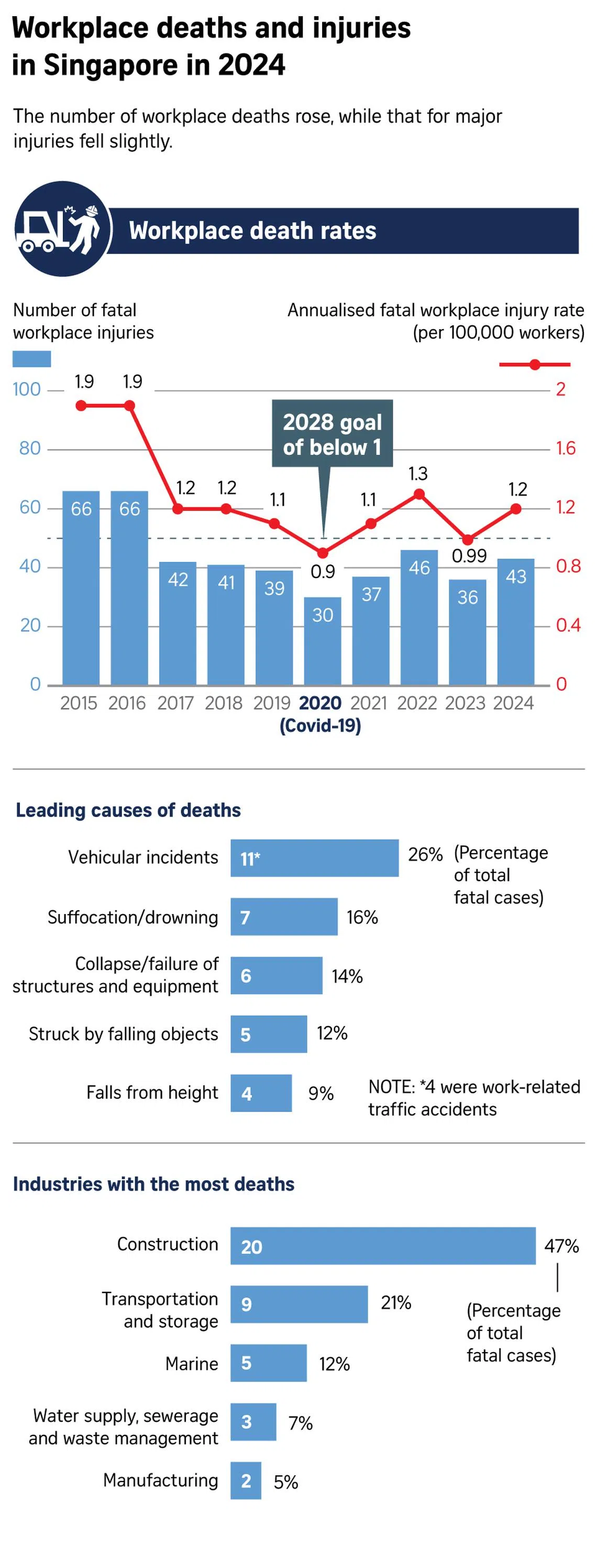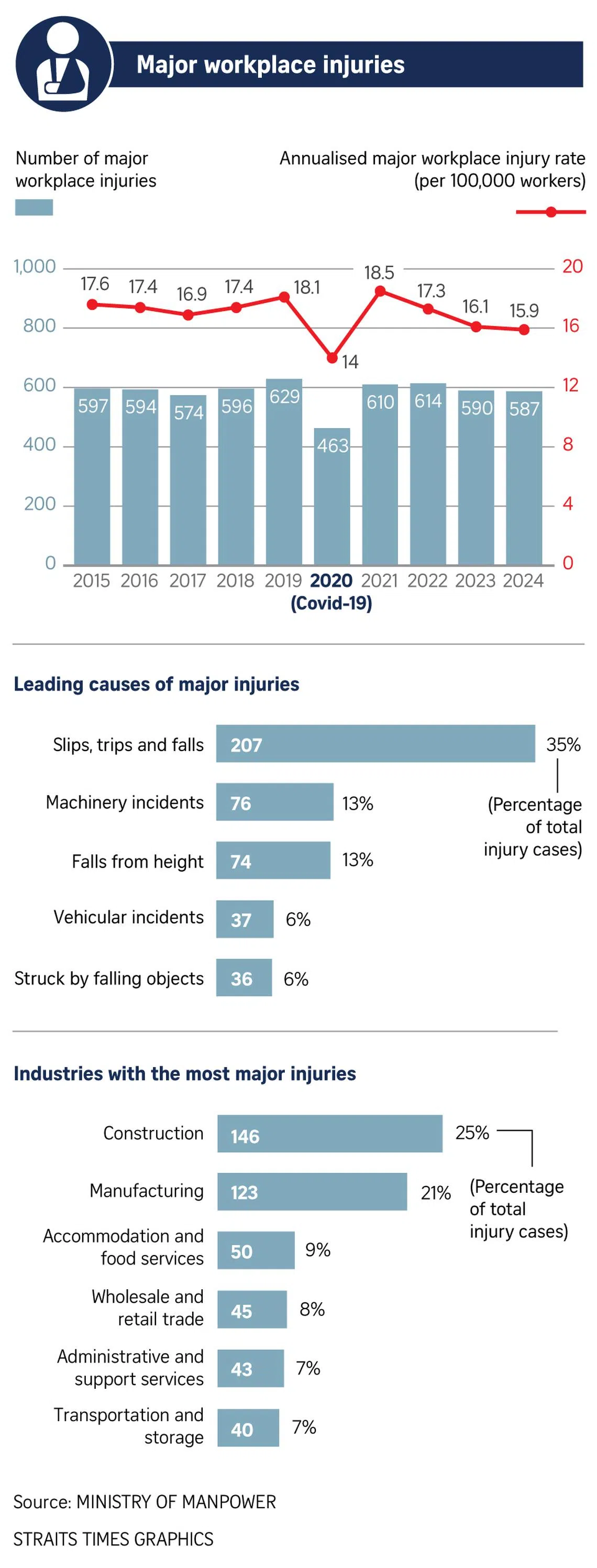Workplace deaths in Singapore rise to 43 in 2024; major injury rate at its lowest
Sign up now: Get ST's newsletters delivered to your inbox

The construction, transport and storage, and marine sectors accounted for 80 per cent of the deaths.
ST PHOTO: NG SOR LUAN
Follow topic:
SINGAPORE – The number of workplace deaths in Singapore crept up to 43 in 2024, after falling to 36 in 2023.
Vehicular incidents were the top cause, followed by suffocation or drowning, and the collapse or breakdown of structures and equipment, said the Ministry of Manpower (MOM) on March 26.
The construction, transport and storage, and marine industries accounted for 80 per cent – or 34 – of the 43 workplace deaths, based on the latest yearly workplace safety and health (WSH) figures released by MOM.
The construction sector recorded 20 deaths in 2024, up from 18 in 2023. These included the deaths of a local site engineer and a Bangladeshi construction worker
The transport and storage sector accounted for nine deaths in 2024, up from eight in 2023.
The marine sector, which did not have any deaths in 2023, recorded five deaths in 2024, two of which involved incidents of suffocation or drowning, said MOM.
The water supply, sewerage and waste management industry had three deaths, and the manufacturing sector recorded two.
At a media briefing on March 25, MOM told reporters that it plans to work with the Maritime and Port Authority of Singapore to ramp up enforcement against offshore marine contractors, particularly divers, as some of them are not using commercial diving equipment.
Some contractors, the ministry added, would opt to use scuba-diving equipment for convenience, since commercial diving gear may be more cumbersome and hinder movement.
On March 26, Senior Minister of State for Manpower Zaqy Mohamad attributed the “surprising” rise in workplace deaths in the marine industry to bad practices that are often missed until incidents happen, as well as safety lapses or complacency.
MOM said it is planning to tighten controls on diving permits, to ensure that these companies have certain safeguards in place before they are allowed to dive.
MOM is also looking to increase the number of inspections in the marine sector in 2025.
On the whole, Singapore’s workplace death rate climbed to 1.2 for every 100,000 workers in 2024, from 0.99 per 100,000 workers in 2023. The workplace death rate fell below the one-per-100,000-workers mark for the first time in 2023, excluding 2020, when the Covid-19 pandemic caused significant disruptions.
Mr Zaqy said the rise in workplace deaths in 2024 showed that staying close to Singapore’s targeted workplace fatality rate of below one per 100,000 workers would entail “a lot more effort” in focusing on higher-risk sectors.
On plans to improve the situation, he said much work has been done to roll out regulations and shift industry players’ mindset.
“On the one hand, I think it’s easy to just say put more regulations, restrictions and constraints, but that would not make companies competitive,” Mr Zaqy told reporters during a visit to chemical manufacturing company Chevron Oronite on Jurong Island.
“Safety is important, so the way to do it is to find productive ways that will not be too interventionist and disrupt the efficiency of their work.”
Excluding 2020 during the Covid-19 pandemic, Singapore registered the lowest rate of major workplace injuries in 2024, with 15.9 such injuries recorded for every 100,000 workers.
There were 587 major injuries reported in 2024 – a marginal decrease from 590 in 2023. Major injuries are severe non-fatal injuries, including amputations, blindness and paralysis.
Mr Zaqy said this shows industries could be catching on to good practices. Moving forward, MOM will need to target particular sectors that have lapses and complacency through increased enforcement and awareness, he added.
The top causes of major injuries were slips, trips and falls, machinery incidents and falls from height.
The construction, manufacturing, and accommodation and food services industries were responsible for 54 per cent – or 319 – of the 587 major workplace injuries in 2024.
Close to half of all major workplace injuries in 2024 took place in the construction and manufacturing sectors.
But MOM noted that there were improvements in the number of major injuries in the construction sector in 2024, with a 2 per cent decrease from the figure in 2023.

Smaller-scale construction activities, referring to addition and alteration works or renovation, registered a 4 per cent drop in major workplace injuries.
Larger-scale, or regular, construction sites witnessed more deaths, climbing from seven in 2023 to 13 in 2024. Regular construction accounted for 47 major injuries in 2024, unchanged from 2023.
In November 2024, the authorities encouraged construction companies to impose a voluntary safety time-out
Meanwhile, the number of major workplace injuries in the manufacturing sector fell from 150 in 2023 to 123 in 2024.
MOM said its targeted inspections and the demerit point system
There was one death in the metalworking industry in 2024, down from two in 2023. The industry recorded 47 major injuries in 2024, down from 59 in 2023.
There was also a 16.7 per cent drop in the death and major injury rate in the food and beverage sector, which MOM attributed to proactive engagement efforts by the ministry and the Singapore Food Agency to educate the industry on good WSH practices.
In 2024, there were 21,527 minor workplace injuries, or non-severe injuries with any instance of medical leave or light duties given.
This was 2.9 per cent lower than the 22,161 cases reported in 2023.
About 71 per cent of these minor injuries posed low fatality risks. Slips, trips and falls, machinery incidents and being struck by moving objects accounted for half of these cases.
The health and social services, manufacturing, and accommodation and food services industries contributed 46.8 per cent of minor workplace injuries in 2024.
The number of workers developing occupational diseases – including noise-induced deafness, musculoskeletal disorders and skin diseases – dipped from 1,229 in 2023 to 899 in 2024.
This was, nevertheless, still an increase from the number in 2021 (659) and was due to growth in the reporting of noise-induced deafness cases with the help of improved surveillance efforts as well as increased awareness among doctors and employers.
MOM said it expects these cases to “remain elevated” over the next few years because of increased awareness.
Nineteen dangerous occurrences – incidents that could cause serious damage, death or injury – at workplaces were reported in 2024, on a par with the 19 incidents in 2023.
Most involved the collapse or breakdown of structures and equipment, while others were caused by fires and explosions.

MOM said it carried out more than 17,000 inspections in 2024, focusing on higher-risk industries such as construction, manufacturing and marine.
The ministry could not provide the total number of inspections done in previous years, saying that these checks target worksites at risk.
The ministry also took enforcement action against more than 16,000 breaches under the WSH Act and regulations.
This included 1,500 composition fines totalling more than $3.1 million, and the issuance of 58 stop-work orders.
MOM noted that more time will be needed for the effects of measures, such as video surveillance systems the greater emphasis on safety in the evaluation of construction tenders,
Mr Zaqy said there has been good progress on video surveillance systems at construction sites, as they allow the ministry to have “one foot in the door” in terms of enforcement and surveillance.
The systems are used to deter unsafe behaviour, identify WSH risks, and aid in investigations into incidents.
Mr Zaqy said MOM is exploring adding a layer of video analytics to these systems, which can process camera footage in real time and detect unsafe behaviour or workplace risks.


